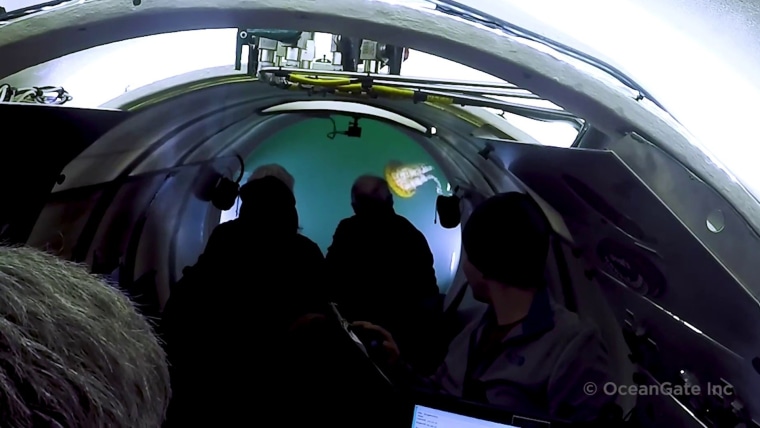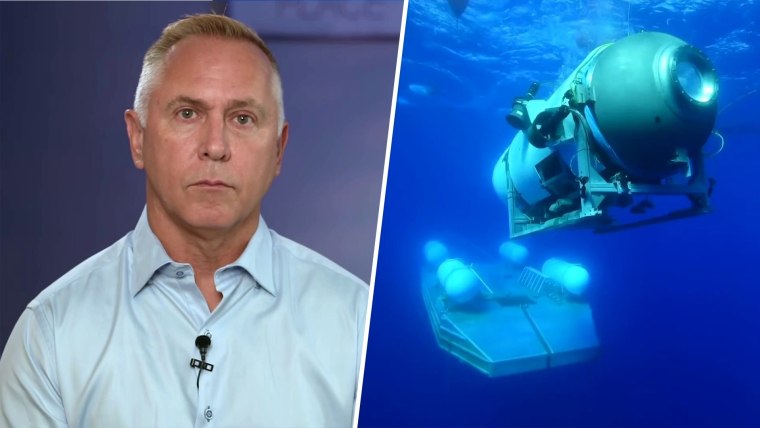It was early 2019, and aerospace engineer Stockton Rush was racing against the clock. The wreckage of the Titanic was slowly decaying — ravaged by metal-eating bacteria, researchers found — and Rush felt there was suddenly a “pressing need to document the world’s most famous shipwreck, combined with a huge demand of people who wanted to go see it.”
“It made perfect sense,” Rush, the CEO of OceanGate Expeditions, told the German broadcaster Deutsche Welle. “We just had to make the submersible to get there.”
The carbon-fiber submersible his team built, known as the Titan, differentiated itself from similar vessels in part because it had room for at least four “affluent travelers,” including an expert. “If you’re going to take somebody to go see the Titanic,” he said, “it’s going to be the most life-changing experience for them. They won’t want to do it alone.”
Follow live updates on the missing Titanic submersible here
Four years later, Rush and four other men, united by their shared zeal for adventure and the financial resources to chase after it, converged on St. John’s, Newfoundland, for the start of their voyage to survey the remnants of a luxury cruise liner that sank 111 years ago. It was OceanGate’s third trip to the remains of the Titanic, with a fare of $250,000 per traveler.
The five-person crew started a dive Sunday morning from the Polar Prince, a Canadian research vessel. The Polar Prince lost contact with the Titan an hour and 45 minutes later.
The passengers are now at the center of a much higher-stakes race against the clock — a frantic international search-and-rescue effort that must succeed before the 22-foot vessel runs out of oxygen Thursday morning.
The passengers are Rush, who lives in Seattle and served as the vessel’s pilot; Hamish Harding, a British tycoon who lives in the United Arab Emirates; Shahzada Dawood and his son Suleman, scions of a Pakistani business dynasty; and the French mariner and Titanic expert Paul Henry “P.H.” Nargeolet, who has been nicknamed “Mr. Titanic.”
The men are likely bound together forever, no matter what happens next.
‘You are not coming back’
Harding, the founder of a UAE-based firm called Action Aviation and a self-described “explorer and adventurer,” appeared to have been driven by a hunger to see the world in all its extremes. (Harding’s family, as well as the immediate families of the other passengers, declined interview requests this week.)
He was a passenger last year on the fifth human spaceflight of Blue Origin, the private space company founded by Amazon mogul Jeff Bezos. In the dark expanse of space, he later told an interviewer, he got an opportunity to “see the world from a different perspective.”
The year before, Harding ventured down to the Mariana Trench in the western Pacific Ocean, 35,000 feet under the sea. He and an American explorer, Victor Vescovo, broke a Guinness World Record for the “longest time spent traversing the deepest part of the ocean on a single dive,” at 4 hours 15 minutes, according to a citation.
Harding was looking for new species and evidence of human pollution, according to news reports from the time. “I want this expedition to contribute to our shared knowledge and understanding of planet Earth,” he told the Khaleej Times, an English-language newspaper published in Dubai.
But he was clear-eyed about the perils of his 7-mile journey to the furthest depths of the ocean, known as Challenger Deep. “If something goes wrong,” he told the Indian magazine The Week, “you are not coming back.”
The former NASA astronaut Terry Virts is one of Harding’s friends and texted with him shortly before he left on his trip. Harding did not seem nervous about the expedition, Virts recalled.
“If you’re going down to the Titanic, there’s risks,” Virts told NBC News’ Tom Costello. “I wouldn’t call him worried. I would say he was aware.”
Shahzada Dawood, 48, and his 19-year-old son, Suleman, a university student, happened to board the Titan over a weekend when parts of the world celebrated Father’s Day. In an undated photo shared with NBC News, the father and son can be seen smiling widely as the sun sets in the background.
The elder Dawood hails from one of Pakistan’s wealthiest families. The family’s namesake business empire, Dawood Hercules Corp., has investments in agriculture, the health sector and other industries. Shahzada is the vice chairman of the Karachi-based Engro Corporation.
Sikander Hazir, a Dawood family spokesman, said in a statement Tuesday that Shahzada and his wife, Christine, have two children as well as a dog named Stig. Shahzada serves as an adviser to Prince’s Trust International, a charitable organization founded by King Charles III. (Shahzada’s father, Hussain, was one of the trust’s founding patrons.)
“Prince’s Trust International has a longstanding relationship with Shahzada Dawood and his family,” Will Straw, the organization’s CEO, said in a statement. “We are shocked by this awful news, praying for a rescue and sending our thoughts to his family during this deeply challenging time.”
In a phone interview Wednesday, a close friend of Shahzada who has known him since high school described him as a reserved and introverted man who enjoyed taking ambitious excursions, including a 2018 trip to Antarctica and a journey through Africa’s Kalahari Desert in December.
Muhammad Hashim, 48, a business owner who lives in Lahore, said he last spoke to Shahzada on Thursday. Dawood was in Ontario, where he was preparing to board a flight to Newfoundland. Hashim was not aware that his son was there, too.
“He wasn’t nervous at all,” Hashim said of the elder Dawood.
Shahzada’s resume hints at an interest in reaching the unknown. He sits on the board of trustees for the California-based SETI Institute, an organization that searches for signs of extraterrestrials and intelligent life in the universe. He also has a keen interest in Titanic lore and frequently visits museum exhibitions featuring artifacts from the wreckage, according to Hashim.
“Shahzada’s interests include photography, especially wildlife photography, gardening, and exploring different natural habitats, while Suleman is a big fan of science fiction literature and learning new things,” said Hazir, the family spokesman.
Shahzada’s longtime friend is trying to remain hopeful. “I hope there’s a happy outcome,” Hashim said, “but I have no idea what to say at the moment. We are keeping our fingers crossed, and that’s it.”
‘We didn’t know what we would discover’
No one aboard the OceanGate submersible knows more about the Titanic than Paul Henry Nargeolet, a former French Navy officer and maritime expert commonly identified by the initials “P.H.” He has spent so much time surveying what remains of the world-famous ship that some refer to him by a grand nickname: “Mr. Titanic.”
Nargeolet directs underwater research for E/M Group and RMC Titanic Inc., a U.S. firm that owns the salvage rights to the wreckage and brings treasures from the doomed cruise liner to museum exhibitions around the world. He has completed 37 dives to the Titanic and overseen the recovery of some 5,000 artifacts, according to the company.
He is also no stranger to OceanGate’s Titan vessel. Nargeolet and an Irish oil executive named Oisín Fanning took the Titan more than 9,000 feet under the sea in 2022, discovering an “extraordinarily biodiverse abyssal ecosystem on a previously unknown basalt formation near the Titanic,” according to a cached version of the company site.
“We didn’t know what we would discover,” Nargeolet was quoted as saying. “On the sonar, this could have been any number of things, including the potential of it being another shipwreck. I’ve been seeking the chance to explore this large object that appeared on sonar so long ago,” he said.
“It was amazing to explore this area and find this fascinating volcanic formation teeming with so much life,” Nargeolet added.
The coral-and sponge-covered formation was “provisionally dubbed” the Nargeolet-Fanning Ridge, according to OceanGate’s site.
In an interview with NBC News, David Gallo, a senior adviser at RMS Titanic, described Nargeolet as his “closest friend and colleague,” “the nicest person you ever want to meet” and a model of “calm, competent” wisdom — whether “he’s on the deck of a ship in the middle of a squall” or “sitting in a Parisian cafe.”
Nargeolet’s past statements suggest he would have agreed with Rush’s assessment that expeditions to the Titanic wreckage were urgent, a matter of historical import.
“In 20 years, most of the deck will be collapsed,” Nargeolet told The Associated Press in 2010. “We’ll still have part of the hull, and the heavy engines will be there for 100 years or more … Maybe some beams will still be there, but everything else will be badly decayed.”
But like Harding, Nargeolet was keenly aware of the risks inherent in their undertaking. In the fall of 2009, he testified at a U.S. District Court hearing in Norfolk, Virginia, that revolved around legal guarantees for Titanic artifacts.
Nargeolet spoke about “the extraordinary expense and risks of deep-sea exploration,” an Associated Press reporter wrote. Nargeolet described the deep-sea environment in stark terms: 150-foot-high icebergs that threatened ships, the “harrowing, claustrophobic voyages 12,000-feet down to the wreck through 33-degree Atlantic waters.”
Aaron Newman — a former passenger on the Titan and an investor in OceanGate who knows Rush, Harding and Nargeolet — told NBC’s “TODAY” show Wednesday morning that he chafed at the idea of calling the three men “tourists.” They were seasoned explorers, not “amateurs.”
“These are people that have lived on the edge for a long time,” Newman said.









Recent Comments